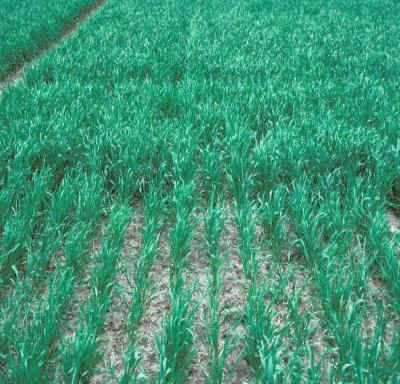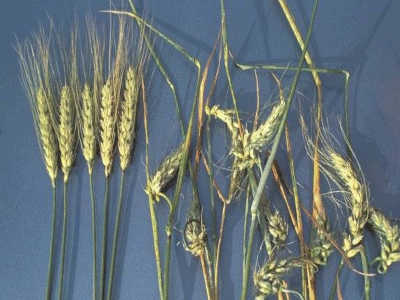By Sarah Lancaster
Producers should pay close attention to the growth stage of their wheat before making spring herbicide applications. Some herbicides must be applied after tillering, several must be applied before jointing, and others can be applied through boot stage. Remember that weeds are most susceptible at early growth stages and coverage becomes difficult as the wheat canopy develops, so the earliest practical and labelled applications generally result in the best weed control.
Applications permitted prior to jointing
Dicamba can be applied to wheat between the 2-leaf and jointing stages of wheat. Application of dicamba after wheat reaches the jointing stage of growth causes severe prostrate growth of wheat and significant risk of yield loss. Dicamba is effective for control of kochia, Russian thistle, and wild buckwheat, but is not good for control of mustard species. Kochia, Russian thistle, and wild buckwheat are summer annual weeds that may emerge before or after wheat starts to joint, so timing of dicamba for control of these weeds can sometimes be difficult. Fortunately, dicamba provides some residual control of these weeds following application.
Products labeled only for use on herbicide-resistant wheat must also be applied prior to jointing. Beyond should be applied to 1 gene ClearField wheats after tiller initiation and prior to jointing, but can be applied to 2-gene ClearField wheats until the second node is detected at the soil surface. Aggressor should be applied to CoAXium wheat varieties after 4-leaf growth stage and before jointing. Beyond should only be applied to ClearField wheat varieties and Aggressor should only be applied to CoAXium wheat varieties.
Other herbicides that must be applied prior to jointing include Agility SG, Olympus, Outrider, PowerFlex HL, Pulsar, and Rave.
Applications permitted through boot
Herbicides that can be applied later in the spring – prior to boot stage – include Ally + 2,4-D, Amber, Finesse, Glean, Starane Flex, and Starane NXT. Starane is a better choice than dicamba products for control of kochia after wheat moves into the jointing stage of growth
2,4-D is labeled for application to wheat from the full-tiller stage until prior to the boot stage of growth, Application of 2,4-D prior hinders the tillering process and can result in significant yield loss if applied too early. Wheat will sometimes exhibit prostrate growth from 2,4-D applications applied in the jointing stage of growth, but yields generally are not significantly affected if applied before the boot stage of growth.
In general, MCPA is safer on wheat than 2,4-D, especially when applied prior to tillering. MCPA can be applied after the wheat is in the three-leaf stage (may vary by product label) until it reaches the boot stage of growth. Neither herbicide should be applied once the wheat is near or reaches the boot stage of growth, as application at that time can result in malformed heads, sterility, and significant yield loss (Figure 2).
Both 2,4-D and MCPA are available in ester or amine formulations. Ester formulations generally provide a little better weed control than amine formulations at the same application rates, but also are more susceptible to vapor drift. However, the potential for vapor drift damage in early spring is minimal. Ester formulations generally are compatible for use with fertilizer carriers, while amine formulations often have physical compatibility problems when mixed with liquid fertilizer.
Applications permitted through flag leaf
Many herbicides used in the spring on wheat can be applied up to the time the flag leaf is visible, or later. One newer product that can be applied from 2-leaf and flag leaf is called Pixxaro EC. It is labeled for control of flixweed, horseweed, kochia, wild buckwheat, and other troublesome weeds.
Other herbicides that can be applied through flag leaf include Affinity BroadSpec, Affinity TankMix, Ally Extra SG, Express, Harmony, Harmony Extra, Huskie, Quelex, Sentrallas, Supremacy, Talinor Weld, and WideMatch must be applied before the flag leaf is visible.

Figure 1. Stunting from an application of 2,4-D to wheat prior to tillering.

Figure 2. Malformed heads from an application of 2,4-D at boot stage.
Source : ksu.edu